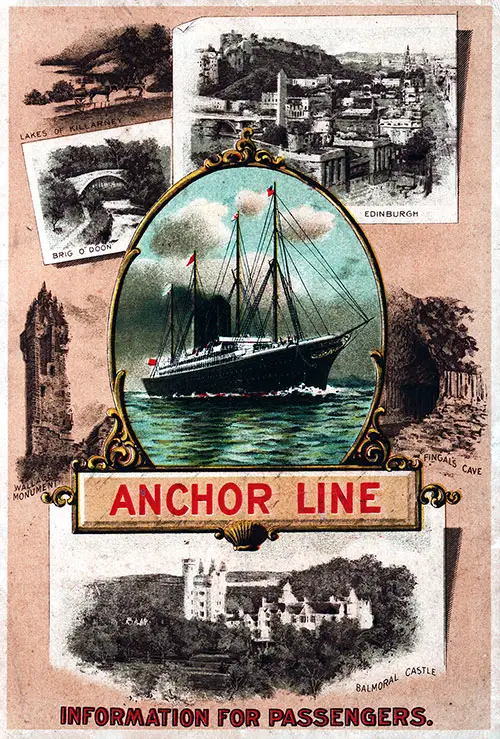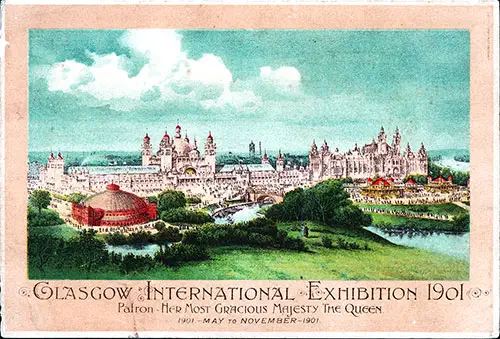SS Ethiopia First & Second Cabin Passenger List – 18 May 1901 – New York to Glasgow (Anchor Line)

Front Cover, First and Second Cabin Passenger List from the SS Ethiopia of the Anchor Steamship Line, Departing Saturday, 18 May 1901, from New York to Glasgow via Moville, Commanded by Captain J. Lumsdane. Front Cover Is an Elaborate Collage of Scenes Around the World, Including: Lakes of Killarney, Edinburgh, Brig O’doon, Wallace Monument, Fingal’s Cave, and Balmoral Castle. in the Center Is a 4-Masted Steamship at Sea With “Anchor Line” in a Banner Directly Below the Steamship at Sea. “Information for Passengers” Is Printed at the Bottom in Bold Red Letters. A Promotional Illustration From the Glasgow International Exhibition of 1901, With Her Majesty the Queen Listed as Patron, Underscores the Voyage’s Connection to a Landmark Cultural Event. | GGA Image ID # 21245bd623
🚢 Ship & Voyage Overview
The SS Ethiopia, a proud vessel of the Anchor Steamship Line, set sail on Saturday, 18 May 1901 from New York bound for Glasgow, Scotland, via Moville, Ireland. Commanded by the experienced Captain J. Lumsdane, this voyage carried a fascinating cross-section of travelers in First and Second Cabin accommodations.
📜 Key Ship Facts
- Launched: 1886 by Alexander Stephen & Sons, Glasgow
- Gross Tonnage: ~4,200 GRT
- Operator: Anchor Steamship Line (Glasgow-based, with strong emigrant and commercial links to the U.S.)
- Typical Route: New York – Moville – Glasgow
- Service Role: Regularly carried passengers, mail, and cargo between Scotland, Ireland, and the United States; also transported many emigrants and seasonal workers.
- Notable Features: A sturdy, four-masted steamship with both sail and steam power, providing extra security on long voyages.
🛳 Key Historical Notes on the SS Ethiopia
Built for the Anchor Line’s New York–Glasgow service, she was part of the company’s push for faster, safer, and more comfortable steam-powered passenger ships.
The combination of steam and sail power was still valued in 1901 for redundancy and fuel efficiency.
This voyage coincided with a period of renewed Scottish pride and industrial achievement, underscored by the Glasgow International Exhibition.
Senior Officers and Staff
- Commander: Captain J. Lumsdane
- Surgeon: Dr. W. Turner
- Purser: F. W. Bowles
- Chief Steward: William Squires
- Stewardess: Mrs. Mason
- Matron: Mrs. Corson
First Cabin Passengers
- Miss Agnes Adie
- Mr. John B. Carrington
- Mr. Henri C. Chatain
- Mr. Robert Caswell
- Mr. Robert R. Davidson, Jr.
- Mr. Robert Y. Davidson
- Mrs. Robert Y. Davidson
- Mrs. Alexander Davis
- Master Albert Davis
- Miss Jessie Davis
- Mr. George E. Fling
- Mrs. George E. Fling
- Mr. William MacLachlan
- Mr. James Morton
- Mr. John McSween
- Mr. John McSween, Jr.
- Mr. John Hector McSween
- Archdeacon James A. R. Swaby
- Mr. Charles Yalier
- Mrs. Isabella Wilkie
- Mr. Bright Williamson
Second Cabin Passengers
- Miss Margaret N. Allison
- Miss Anderson
- Mrs. Margaret Beicher
- Mr. S. H. Blount
- Mrs. Ellen Blount
- Miss Esther Blount
- Mrs. M. J. Blount
- Mrs. Catherine Bradley
- Master Joseph Bradley
- Mr. Walter Brown
- Miss Jeannette Crawford
- Mrs. Mary Duplessis
- Master Edgar Duplessis
- Mr. John Donaghey
- Mrs. John Donaghey
- Miss Sophia Eastman
- Miss J. Egland
- Miss I. Egland
- Miss S. J. Ferguson
- Miss Anna Flaherty
- Mr. William N. Garry
- Miss Mary A. Gaw
- Mr. George Gillies
- Mr. George Gillies, Jr.
- Mrs. Annie Henderson
- Master J. W. Henderson
- Master George Henderson
- Miss Mary L. Irwin
- Mr. Thomas Kidd
- Mrs. Thomas Kidd And infant
- Mr. John Kavane
- Miss Catherine Lecky
- Mr. Thomas Linehan
- Mr. William Murray
- Miss McFarland
- Miss Mary McPeak
- Mr. John McVie
- Miss C. McCormick
- Miss Eliza Muir
- Miss Jane Maxwell
- Mr. Munro
- Mr. James Merry
- Mrs. James Merry
- Miss Florence Merry
- Mrs. Mary Martin
- Miss Alice Martin
- Mr. Robert Morrison
- Mr. William Reid
- Miss Janet Sheppard
- Miss Margaret Sheppard
- Mr. James Sutton
- Mrs. James Sutton
- Mrs. Ellen Tully
- Miss Mary A. Tearney
- Miss Mary Ward
- Miss Annie Watt
- Mrs. Elizabeth Wilkinson
- Miss Ester I. Wilkinson And infant
👥 Notable Passengers & Historical Context
✝ Religious Leadership
Archdeacon James A. R. Swaby – A prominent Anglican cleric, the title Archdeacon denoting senior ecclesiastical authority. Figures like Swaby often traveled to oversee church missions, attend conferences, or provide pastoral care to expatriate communities. His presence highlights the ship’s role in maintaining spiritual and institutional connections across the Atlantic.
🎓 Academic & Professional Travelers
Mr. George E. Fling & Mrs. George E. Fling – George E. Fling was associated with the academic and cultural circles of the early 20th century, later linked to educational institutions in the United States. Their voyage may have been for research, cultural exchange, or professional networking in Scotland or England.
🌍 International & Cultural Cross-Section
The manifest reveals a blend of Scottish, Irish, and American passengers—merchants, families, and independent women travelers—demonstrating that 1901 transatlantic crossings served both emigrants and those making return journeys to visit relatives or manage business interests.
📌 Most Engaging Aspects of This Passenger List
Diverse Occupations and Social Roles – From senior clergy to academics, business travelers, and families with children, the list reflects the social range of early 20th-century maritime travel.
Strong Scottish and Irish Passenger Representation – Many surnames and origins connect to specific regions, making this a rich source for genealogical research.
Women Traveling Independently – Several women appear without male companions, a reflection of growing independence and the professional mobility of women in the Edwardian era.
Cultural Significance of the Year 1901 – The voyage coincided with the Glasgow International Exhibition, featured on the back cover, which celebrated industrial, scientific, and artistic achievements in Scotland.
📚 Relevance for Researchers & Educators
For Teachers & Students
A vivid case study for the Edwardian period, offering insights into travel patterns, societal hierarchies, and transatlantic relations.
Useful for lessons in migration history, social studies, and cultural geography.
For Genealogists
First- and second-cabin listings provide rich detail for family historians tracing ancestors who traveled in comfort but not necessarily in luxury.
The period context allows for deeper understanding of why and how individuals traveled between the U.S. and the British Isles in 1901.
For Historians
The voyage serves as a microcosm of transatlantic society in the early 20th century, just months before the death of Queen Victoria and the start of the Edwardian era.
💡 Final Thoughts – Why This Passenger List Matters
The 18 May 1901 Passenger List of the SS Ethiopia captures a transitional moment in maritime and social history. It reflects an era when steamships were at their height, carrying people not only for migration but also for cultural, religious, and professional purposes. For genealogists, it offers a treasure trove of names; for historians, it situates the voyage within the broader context of Edwardian society and international exhibitions.

Back Cover, SS Ethiopia First and Second Cabin Passenger List, 18 May 1901. Back Cover is an illustration from the Glasgow International Exhibition of 1901. Patron - Her Most Gracious Majesty The Queen. 1901- May to November - 1901. | GGA Image ID # 21246830d4
🎨 Illustrated Profile – Glasgow International Exhibition of 1901
The Glasgow International Exhibition of 1901 was a landmark cultural and industrial showcase held in Kelvingrove Park, Glasgow, from May to November 1901. Under the patronage of Her Most Gracious Majesty The Queen, the event celebrated Scotland’s industrial might, artistic excellence, and global connections.
🏛 Exhibition Highlights
Architecture: The main exhibition building was an Edwardian-Baroque masterpiece, crowned with a central dome and adorned with ornate towers—symbolizing both tradition and modernity.
International Pavilions: Nations from across the globe, including Canada, India, and European powers, displayed their achievements in trade, manufacturing, and art.
Scientific & Industrial Displays: Cutting-edge machinery, shipbuilding innovations, and engineering marvels reflected Glasgow’s status as the “Second City of the Empire.”
Cultural Arts: The Fine Arts section featured works from Scottish masters alongside international artists, bridging heritage and contemporary trends.
📸 Connection to the SS Ethiopia
The back cover of this passenger list proudly features an official illustration of the Glasgow International Exhibition of 1901, subtly linking the voyage to this world-class event. For many passengers—particularly tourists, academics, and dignitaries—this may have been the main purpose of their journey to Scotland.
Noteworthy Image from the Passenger List
Back Cover – Official illustration promoting the Glasgow International Exhibition, 1901. The image depicts the grandeur of the exhibition grounds, reinforcing Glasgow’s global prestige at the dawn of the 20th century. | GGA Image ID #21246830d4.
📜 Research note: Some names and captions were typed from originals and may reflect period spellings or minor typographical variations. When searching, try alternate spellings and cross-check with related records. ⚓
Curator’s Note
For over 25 years, I've been dedicated to a unique mission: tracking down, curating, preserving, scanning, and transcribing historical materials. These materials, carefully researched, organized, and enriched with context, live on here at the GG Archives. Each passenger list isn't just posted — it's a testament to our commitment to helping you see the people and stories behind the names.
It hasn't always been easy. In the early years, I wasn't sure the site would survive, and I often paid the hosting bills out of my own pocket. But I never built this site for the money — I built it because I love history and believe it's worth preserving. It's a labor of love that I've dedicated myself to, and I'm committed to keeping it going.
If you've found something here that helped your research, sparked a family story, or just made you smile, I'd love to hear about it. Your experiences and stories are the real reward for me. And if you'd like to help keep this labor of love going, there's a "Contribute to the Website" link tucked away on our About page.
📜 History is worth keeping. Thanks for visiting and keeping it alive with me.
